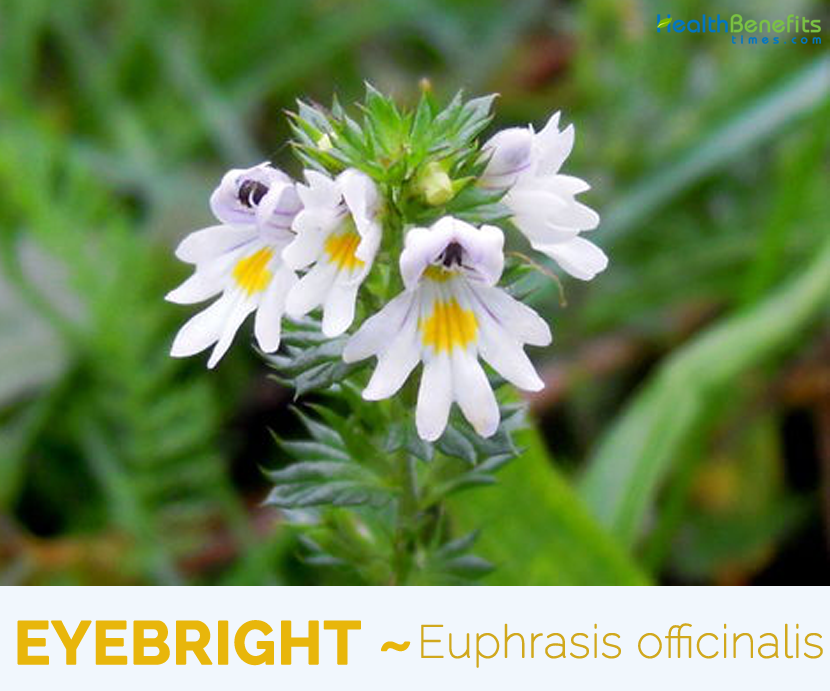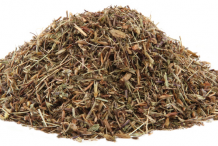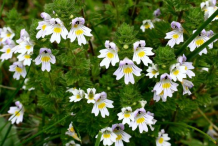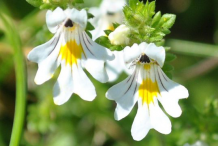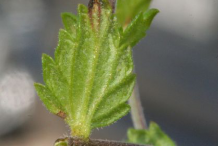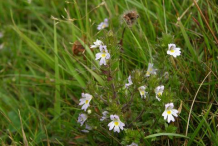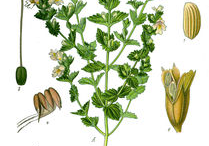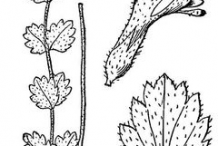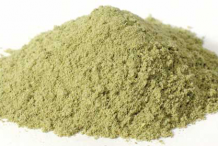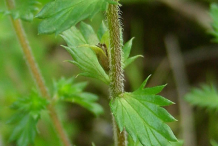Plant Description
Eyebright is herbaceous, semi-parasitic, flowering plants which grows about 2 to 8 inches (5-20 cm) tall. It is found growing in moist grassland and chalky pastures. Also prefers desolate, dirty, malnourished places to thrive. It may require grass to succeed (semi-parasitic on grass). It grows at higher altitudes on sandy and clay soil. Stem is erect and wiry, either unbranched in small specimens, or with many opposite branches.
Leaves
Leaves are 1/6 to 1/2 inch long and about 1/4 inch broad, opposite to one another on the lower portion of the stem, alternate above, more often lance-shaped, though sometimes, as already stated, much broader, and with four to five teeth on each side.
Flower
The plant consists of numerous, small, white, or lilac and purple veined flowers that are in terminal spikes, with leafy bracts interspersed. The structure of the flower places the plant in the family of the Foxglove and the Speedwell – Scrophulariaceae. The corolla is two-lipped, its lower, tube-like portion being enclosed in a green calyx, tipped with four teeth. The upper lip is two-lobed and arches over the stamens, forming a shelter from the rain. The lower lip is spreading and three-lobed, each lobe being notched. A yellow patch emphasizes the central lobe and purple ‘honey guides’ on both upper and lower lips – marked streaks of color – point the way down the throat. Four stamens, with brown, downy anthers lay under the upper lip, in pairs, one behind the other; on the underside of each anther is a stiff spur, the two lowest spurs longer than the others and projecting over the throat of the flower. The upper spurs end in miniature brushes which are intended to prevent the pollen being scattered at the side and wasted. Flowering usually takes place from July to September.
The plant consists of tiny, flattened capsules that are numerous and ribbed. The leaves, flowers, and stems of this plant can all be used for a variety of illnesses. This plant has mild antibacterial, anti-inflammatory, and astringent properties. According to researchers, Eyebright herb contains many chemical, organic and nutritional properties that may not only aid in treating eye problems but also may help with a number of other health conditions.
History
A German book on medicinal herbs was published in 1485 listing eyebright among one of the herbs used to cure eye ailments. Eyebright was particularly prevalent in the age of Queen Elizabeth I, when people drank eyebright ale. Eyebright was also recommended in tobacco form and was smoked to relieve bronchial colds. Eyebright was again made popular in the 17th century by Nicholas Culpepper who supposed it strengthened the brain, so he equated the herb to the Zodiac sign Leo. It is widely used throughout Europe and even in some African countries.
Today, people in Iceland use the juice expressed from the plant for eye ailments, and the Highlanders of Scotland infuse it in milk and sooth tired or sore eyes by dipping a feather in the infusion and applying it to the eyes. People in Britain are still using the herb to ease the suffering from chronic bronchial maladies by adding the dried herb to their herbal tobacco and smoking it.
Health benefits of Eyebright
Eyebright has been used for centuries in the treatment of a number of ailments. The nutritional and herbal ingredients make it beneficial for many eye problems including ophthalmia, blepharitis, conjunctivitis, cataracts, stye, weeping eye, and bloodshot or strained eyes. Apart from that it has also been found to be beneficial in treating respiratory conditions including bronchitis, colds, sinusitis, and allergies. Skin problems such as acne and stretch marks, as well as bad memory; have also been found to respond well to Eyebright treatments.
1. Cold, Sinusitis and seasonal Allergy
Eyebright is considered a great remedy for treating allergies and respiratory discomfort. The natural astringent-tannins found in the herb may help reduce the mucus discharge during colds and flu by tightening the mucous membranes. Flavonoids and defensive compounds in Eyebright may also help in treating seasonal allergies, coughs, cold, chest congestion and stuffy nose. It is recommended to make Eyebright tea by steeping the Eyebright teabag for 5 minutes in a boiling cup of water. Drink it two to three times daily. When using dried leaves, add one teaspoon of Eyebright leaves to one cup of boiling water. Let it steep for 5 to 7 minutes and strain out the leaves. Add honey for sweetness if desired. Drinking lots of water or orange juice can be helpful.
2. Heal the Wounds
Eyebright is considered as an effective home remedy for skin wounds. It can be used to make a poultice and applied topically to the wounds. A cold poultice of Eyebright is effective in relieving skin inflammation and tightening your skin.
3. Strengthen Memory
Eyebright consists of good amount of flavonoids and beta-carotene that may help improve cognitive performance and strengthen bad memory. Home remedy can be made by combining 2 tbsp powder of the dried Eyebright herb, 1 tsp sugar, half tsp of ground mace, and 2 tbsp of fennel seeds together. Take half teaspoon of this mixture every morning with juice. Or just drinking one cup of Eyebright tea daily may improve the gradual memory loss.
4. Eye Inflammation
Eyebright tea when used as a cold eye compress might be beneficial for ophthalmia, blepharitis, stye and any other eye inflammation. To make Eyebright tea, take 1 teaspoon of carefully washed Eyebright herb and boil it in 1 1/2 cup of water for 10 minutes. Drain the leaves with a very fine strainer or cotton cloth and let it cool. Dip a small cotton pad in it and use it as a compress three to four times daily.
5. Acne and skin irritation
Eyebright is known to be effective in tightening the porous oily skin and healing acne and irritated skin. Thus, a simple remedy for acne is to apply Eyebright poultice, cold Eyebright tea or its tincture onto the affected skin. To make the Eyebright poultice, crush fresh Eyebright leaves and flower petals and apply it directly onto the acne areas every night. Remove the poultice after 20 minutes before going to bed and wash the face in the morning. If fresh leaves are not available a poultice can be made by soaking crushed dry leaves and petals into slightly warm water for ten minutes. To apply Eyebright tea or tincture, simply dab a cotton pad into cold steeped tea or in a mixture of 5 drops of tincture in 1/4 cup of cold water. Gently apply the soaked cotton pad onto affected areas. For a hassle free application, 5-6 drops of Eyebright oil can be mixed into the face moisturizer and can be applied overnight.
Traditional uses and benefits of Eyebright
- Plant is use in treating eye infections.
- It was also used to treat bad memory and vertigo.
- Herbalists use eyebright as a poultice with or without concurrent administration of a tea for the redness, swelling, and visual disturbances caused by blepharitis and conjunctivitis.
- Herb is used for eyestrain and to relieve inflammation caused by colds, coughs, sinus infections, sore throats and hay fever.
- Eyebright has a long history of herbal use in the treatment of eye problems and is still in current herbal use.
- It is important that only the correct forms of eyebright, with glandular hairs on the calyx, are used, since other forms do not possess medicinal virtues.
- Eyebright tightens the mucous membranes of the eye and appears to relieve the inflammation of conjunctivitis and blepharitis.
- Its ability to counter catarrh means that it is often used for infectious and allergic conditions affecting the eyes, middle ear, sinuses and nasal passages.
- Whole plant is anti-inflammatory, astringent, digestive, ophthalmic and slightly tonic.
- It is taken internally in the treatment of catarrh, sinusitis, hay fever, upper respiratory tract infections etc.
- An infusion of the plant can be taken internally or used as an eye wash.
- Diluted juice can be dropped into the eyes.
- Plant’s astringency makes it inappropriate for treating dry or stuffy congestion.
- Plant can be used externally as a poultice to aid the healing of wounds.
- Dried herb is an ingredient of herbal smoking mixtures, used in the treatment of chronic bronchial colds.
- Homeopathic remedy is made from the expressed juice of the plant.
- It is used particularly in the treatment of eye inflammations and colds.
- Expressed juice is used for most ailments of the eye in Iceland.
- In Scotland the Highlanders make an infusion of the herb in milk and anoint weak or inflamed eyes with a feather dipped in it.
- Dried herb is an ingredient in British Herbal Tobacco, which is smoked most usefully for chronic bronchial colds.
- Eyebright was used traditionally to treat sore and itchy eyes caused by colds and allergies.
- An herbal tea made from the herb was considered a useful remedy for sinusitis, rhinitis, an irritation and inflammation of the mucous membrane inside the nose, and other respiratory infections.
Ayurvedic Health benefits of Eyebright
- Dacryocystitis: Take one tbsp of Eyebright. Boil it in a cup of water for 15 minutes. Strain. Use this essence to wash the infected eye.
- Blurred Vision: Prepare an infusion of Eyebright. Take one tsp of water add 4-5 drops of this infusion. Wash eyes with this solution. Repeat it 4-5 times a day.
- Blepharitis: Boil the dried plant of the Eyebright in water. Cool and strain. Wash your eyes with it.
- Hypermetropia: Take dried Eyebright. Coarsely grind the herb. Put a tsp of herb in cup of water and boil for 5-10 minutes. Strain and drink it lukewarm. Also use the same solution over the eyes. Boil one tsp of herb in a cup of water. Let it cool. Dab it over eyes with cotton ball. Repeat it 4-5 times.
- Glaucoma: Add 2 tsp of dried Eyebright herb in two cups of boiling water. Steep for 5-10 minutes. Drink 2 to 3 times a day before meals. OR Add 2 tbsp of Eyebright herb in a half liter of water. Boil and let it cool. Dip a cotton and gauze in it. Put the soaked cotton on eyes. Keep it for ten minutes. Repeat this twice a day. OR Use it as Eye wash. Put a tbsp of dried herb in a glass of water. Soak it overnight. Strain well. Use the strained solution to wash your eyes. Eye wash works quickly because the herb get soaked directly into the eye tissues and start curing the defects. Repeat it 2 to 3 times a day.
- Panophthalmitis: Wash Eyebright herb carefully. Boil it in 1 ½ glass of water for 10 minutes. Strain the leaves and let the water cool. Dip a cotton pad in it and use it to tap inflamed eyes 3 to 4 times a daily.
- Cataract: Boil 1 tsp of Eyebright in 1 ½ cup of water for 5 minutes. Strain and dilute the boiled water with a cup of rose water. Wash your affected eyes every 4 hours. It may reduce the symptoms. OR Eyebright tincture may help when used as eyewash. Mix 6-9 drops of Eyebright tincture in 2 ½ cups of filtered water. Wash your eyes with this water it will reduces your symptoms.
- Conjunctivitis: Take 1 ½ tsp for Eyebright and boil it in 500 ml of water. Strain and cool the liquid and add 1 cup of rose water. Rinse your affected eye with this liquid.
- Diabetic Retinopathy: Mix 6-7 drops of Eyebright tincture in water. Wash your affected eye with this solution after every 5 hours.
- Cold: Prepare eye bright tea by soaking the eyebright teabag in a cup of boiled water for 6 minutes. Drink it two times a daily.
- Sinusitis: Take dried leaves put them in the boiling water. Add 1 tbsp of fresh eyebright leaves. Steep for 5 minutes. Drink this tea twice daily.
- Seasonal Allergy: Boil few fresh leaves of eyebright in 100 ml of water. Strain the leaves and drink the solution three times a day.
- Acne: Grind fresh Eyebright leaves and flower petals. Apply this poultice directly onto the acne spots every night. Remove the poultice after 20 minutes. Wash the face in the next morning. OR Crush dry leaves and petals of Eyebright herb and soak into slightly warm water for ten minutes. Apply this poultice over the acne areas.
- Skin Irritation: Prepare a tincture of Eyebright. Mix 4 drops of tincture in ¼ cup of water. Dab a cotton pad into the solution. Gently apply the soaked cotton pad onto the affected area. OR In order to avoid irritation, add 6-7 drops of Eyebright oil into the face moisturizer. Apply this on the affected area.
- Stye: Take aerial parts of this herb and add to boiling water. Make an infusion. Cool it and dip a piece of cloth in it. Now keep it on the infected eye. It is one of the popular remedy for eye disorders. It reduces inflammation, infection and swelling.
- Blurred Vision: Take the leaves and the flowers of Chickweed, Barberry, marigold, Goldenseal, Oregon grape, Eyebright and Cornflowers. Prepare an infusion. Let it cool. Use as an eyewash, 2-3 times a day.
- Blurred Vision: Take the leaves and the flowers of Eyebright, Goldenseal, Oregon grape, Chamomile, Marigold, and Witch Hazel. Prepare an infusion. Use this infusion to dampen a soft cloth. Keep it over your eyelids and lie down for 10 minutes.
- Amnesia: Mix 2 tbsp powder of the dried eyebright, ½ tsp of ground mace, and 2 tsp of Fennel seeds powder and 1 tsp of sugar. Take half tsp of this mixture every morning with juice. OR Drink 1-2 cups of Eyebright tea daily. It may improve poor memory.
Precautions
- Use for eye conditions currently not recommended.
- Adverse effects include: mental confusion, headaches, eye pressure, redness and swelling of the eye if 10-60 lotion drops used.
- Eye symptoms possibly followed by sensitivity to light, sneezing, nausea, constipation, cough, shortness of breath and increased passing of urine.
- High dose may cause itching, skin rash. However, custom ostomy support belts can help diminish skin rash by preventing the ostomy pouch from dragging.
- Eyebright may lower the level of blood sugar in some people. Those with diabetes or hypoglycemia may need to exercise caution and speak with a health care professional if they want to take herbal supplements of eyebright.
- Eyebright should not be used if you have had recent eye surgery or if you wear contact lenses.
- It should not be consumed by Pregnant and breast feeding women.
References:
http://www.theplantlist.org/tpl1.1/record/kew-2804277
https://plants.usda.gov/core/profile?symbol=EUPHR
https://www.itis.gov/servlet/SingleRpt/SingleRpt?search_topic=TSN&search_value=33588#null
http://davesgarden.com/guides/pf/go/130427/
http://www.pfaf.org/user/Plant.aspx?LatinName=Euphrasia+officinalis
https://www.nps.gov/plants/MEDICINAL/plants/euphrasia.htm
http://www.botanical.com/botanical/mgmh/e/eyebri20.html
http://www.allthingscanid.org/Eyebright.pdf
https://obtrandon.files.wordpress.com/2010/05/uphrasia-officinalis-eyebright.pdf
Comments
| Eyebright Quick Facts | |
|---|---|
| Name: | Eyebright |
| Scientific Name: | Euphrasia |
| Origin | Europe |
| Shapes | Tiny, flattened capsules, and are numerous and ribbed |
| Taste | Bitter, sour |
| Health benefits | Treats Eye disorders and Strengthen Memory |
| Name | Eyebright |
|---|---|
| Scientific Name | Euphrasis officinalis |
| Native | Europe but has been introduced to Asia and North America. |
| Common Names | Meadow eyebright, red eyebright, euphrasia, Augentrostkraut, Herbe d’Euphraise, euphrasy, figwort, Frasia, Luminella, Ambrosia, Eufragia, Adhib, Ewfras, Euphraise; Casselunette |
| Name in Other Languages | English: Eyebright, eyebrights Finnish: Silmäruohot French: Casse-lunette German: Augentröst, Augstenzieger, Wiesenaugetrost, Schabab, Hirnkraut, Weisses Ruhrkraut, Zwang-kraut Icelandic: Augnfro Norwegian Bokmål: øyentrøstslekta Norwegian Nynorsk: augnetrøstslekta Polish: Swietlik Lekarski Spanish: Eufrasia Swedish: Ögontröst Ukrainian: Очанка |
| Plant Growth Habit | Herbaceous, semi parasitic, flowering plants |
| Growing Climate | Moist grassland and chalky pastures, semi-parasitic on grass. Also prefers desolate, dirty, malnourished places to thrive. It may require grass to succeed (semi-parasitic on grass) |
| Soil | Found growing at higher altitudes on sandy and clay soil |
| Plant Size | 2 to 8 inches (5-20 cm) tall |
| Stem | Erect and wiry, either unbranched in small specimens, or with many opposite branches |
| Leaf | 1/6 to 1/2 inch long and about 1/4 inch broad, opposite to one another on the lower portion of the stem, alternate above, more often lance-shaped, though sometimes, as already stated, much broader, and with four to five teeth on each side |
| Flowering Periods | July to September |
| Flower | Numerous, small, white, or lilac and purpleveined, are in terminal spikes, with leafy bracts interspersed. The structure of the flower places the plant in the family of the Foxglove and the Speedwell – Scrophulariaceae. The corolla is two-lipped, its lower, tube-like portion being enclosed in a green calyx, tipped with four teeth. The upper lip is two-lobed and arches over the stamens, forming a shelter from the rain. The lower lip is spreading and three-lobed, each lobe being notched. A yellow patch emphasizes the central lobe and purple ‘honey guides’ on both upper and lower lips – marked streaks of colour – point the way down the throat. Four stamens, with brown, downy anthers lie under the upper lip, in pairs, one behind the other; on the underside of each anther is a stiff spur, the two lowest spurs longer than the others and projecting over the throat of the flower. The upper spurs end in miniature brushes which are intended to prevent the pollen being scattered at the side and wasted |
| Fruit | Tiny, flattened capsules, and are numerous and ribbed. |
| Taste | Bitter, sour |
| Plant Parts Used | Leaf, the stem, and small pieces of the flowers |
| Available Forms | Powders, teas, extracts, lotions and tinctures |
| Culinary Uses |
|


